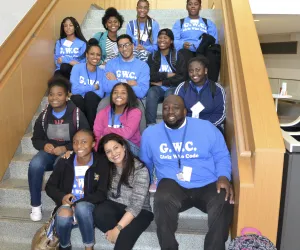Reshma Saujani is on a mission to close the gender gap in technology. She has an ally at North High School.
Saujani founded the non-profit organization Girls Who Code, which offers coding summer programs and after-school clubs to teenage girls across the country. She spoke at the 14th-annual Achieve Minneapolis Education Partners Luncheon on Oct. 25 with girls from North’s new Girls Who Code program in the audience.
“We are not giving girls a chance to get those jobs” in science, technology, engineering and math, Saujani said. “… If we want to solve the problems of today and tomorrow, teach our girls how to code.
Saujani’s passion for closing the gap began after her unsuccessful run for a New York City congressional seat in 2010. She said running for Congress was the first time in her life she had done something “truly brave, where I didn’t worry about being perfect.”
“I’m not alone,” she said during a TED Talk this past February. “So many women I talk to tell me that they gravitate towards careers and professions that they know they’re going to be great in, that they know they’re going to be perfect in, and it’s no wonder why.”
Girls have been socialized to be perfect, Saujani said, whereas boys have been socialized to be brave. Later in life, that means boys are more comfortable taking risks in their career, she said.
Saujani set about to socialize girls to be brave by teaching them computer programming. Coding, she said, is a process of trial and error that requires perseverance and imperfection.
Saujani started in 2012 with 20 girls in New York and has expanded the organization to reach more than 40,000 in every state. It operates about 1,500 clubs nationwide, including five in Minnesota.
It also offers free summer immersion programs to 10th- and 11th-grade students at the nation’s top technology companies, such as Facebook and Microsoft.
“For the American economy, for any economy to grow, to truly innovate, we cannot leave behind half our population,” she said in her TED Talk. “We have to socialize our girls to be comfortable with imperfection, and we’ve got to do it now.”
‘A lot of brain’
Saujani hopes clubs such as the one at North High can help with that mission. Started by Gear Up coordinator Thomas Waltower, the girls in the club are using the free programming language Scratch, developed by the MIT Media Lab, to experiment with coding different games and animations.
“Right now, it’s a lot more about exploration and playing and seeing what works and what doesn’t,” said math teacher Justin Goldstein, who helps Waltower with the club.
The girls appeared engaged at a recent meeting, laughing and dancing as they manipulated the program to play different sounds and animations.
Ninth-grader Tyshawna Hubbert said she wanted to learn coding because it could make it easier for her to get a job. Hubbert also said it presents her the opportunity to meet new people and make her own website.
Ninth-grader Toyana Anderson offered similar reasons for joining the club, adding that coding was something she had done at her old school. Anderson said she likes coding because it’s a hands-on experience and something that could pay dividends down the road.
“Coding takes a lot of brain,” ninth-grader Taryn Jiles said. “If we can do coding, basically we can kind of do anything.”
Work to do
Statistics show that Saujani and others looking to close the technology gap still have plenty of work to do. Women hold just 24 percent of computing jobs in the U.S. and represent just 18 percent of all computer science graduates, figures that are significantly lower than in past years. Girls Who Code projects the percentage of women in computing jobs will decrease unless more action is taken.
The organization recommends deepening girls’ hands-on computing experience, changing their perceptions of computing and supporting parents and teachers in understanding the role of computing as just a few examples of ways to lessen the gap.
“For so long we have created in our culture basically images that girls are not good at math and science,” Saujani said at the luncheon. “We have created a culture that tells girls it’s cool to hate math.”
She has partners in Minneapolis, including University of Minnesota Ph.D. students Morgan Meissner and Ashley Arthur, who are earning doctorates in cell biology. The duo started work in bioinformatics when they realized they hadn’t learned coding as undergraduates, something they said would have been nice to know.
They decided to go for master’s degrees in bioinformatics. They also inquired about volunteering for a local Girls Who Code club only to realize there weren’t any. That led them to start their own chapter at the university, which now has 28 students from about 15 schools, including some in Minneapolis.
The program focuses on the core four computer-science concepts that form the basis for all programming languages. In the spring, the girls will build an app to help refugees in Minneapolis.
“It’s something really new for them,” Arthur said of coding. “It’s something that we still think of as hard, and now that they’re playing around, it’s less intimidating.”
